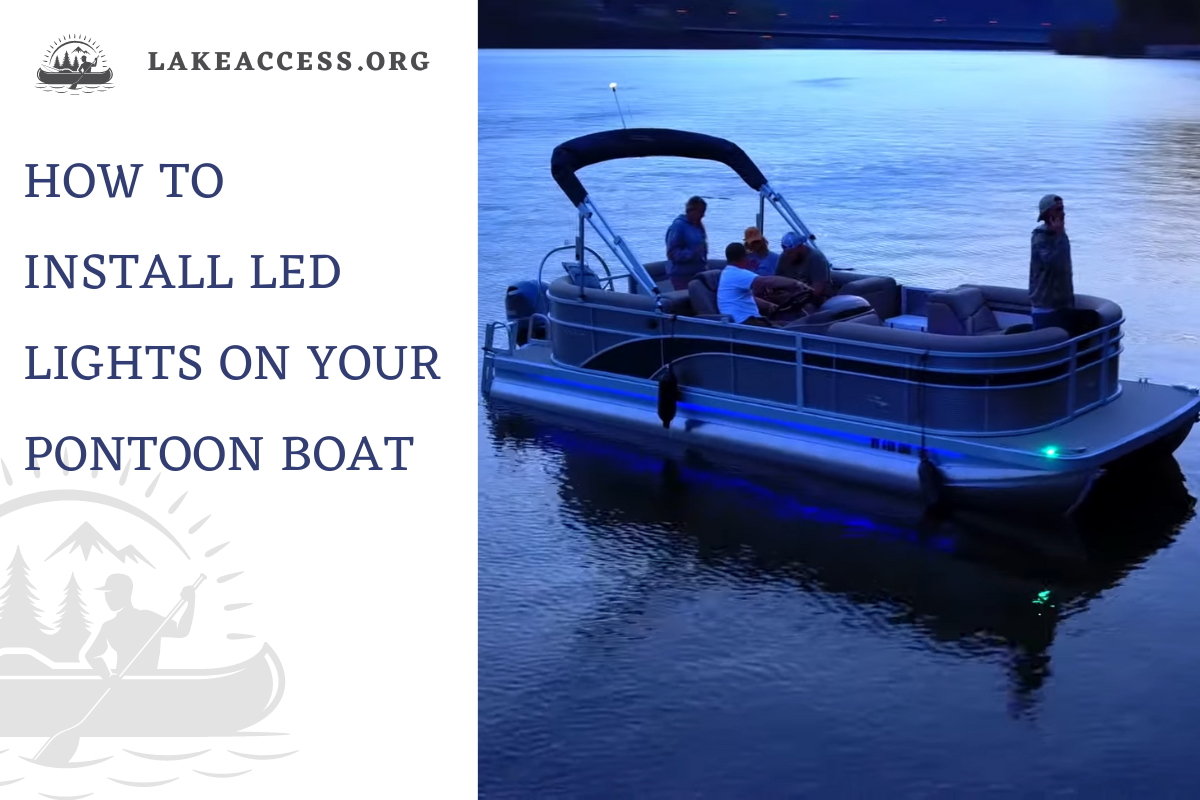Are you ready to take your pontoon boat to the next level? Adding LED lights is a simple and cost-effective way to enhance your boat’s appearance and functionality. Not only do LED lights make your boat look amazing, but they also provide better visibility in low-light conditions, making it safer to navigate at night. In this step-by-step guide, we’ll show you how to install LED lights on your pontoon boat, so you can enjoy your boat even more after the sun goes down. Whether you’re a seasoned boater or a newbie, we’ve got you covered with easy-to-follow instructions and tips to help you get the job done right. So, let’s get started!
What are LED lights?
LED lights are an incredibly efficient form of light source that produces light when an electron passes through it. They are much smaller and consume less energy than traditional light bulbs, making them suitable for use in small spaces such as boats. LEDs come in a variety of colors, making them ideal for maritime use in low-visibility situations. LEDs are not bulbs but, instead, semiconductors that can emit electromagnetic interference, so it is important to ensure the LED lighting purchased is shielded against EMI.
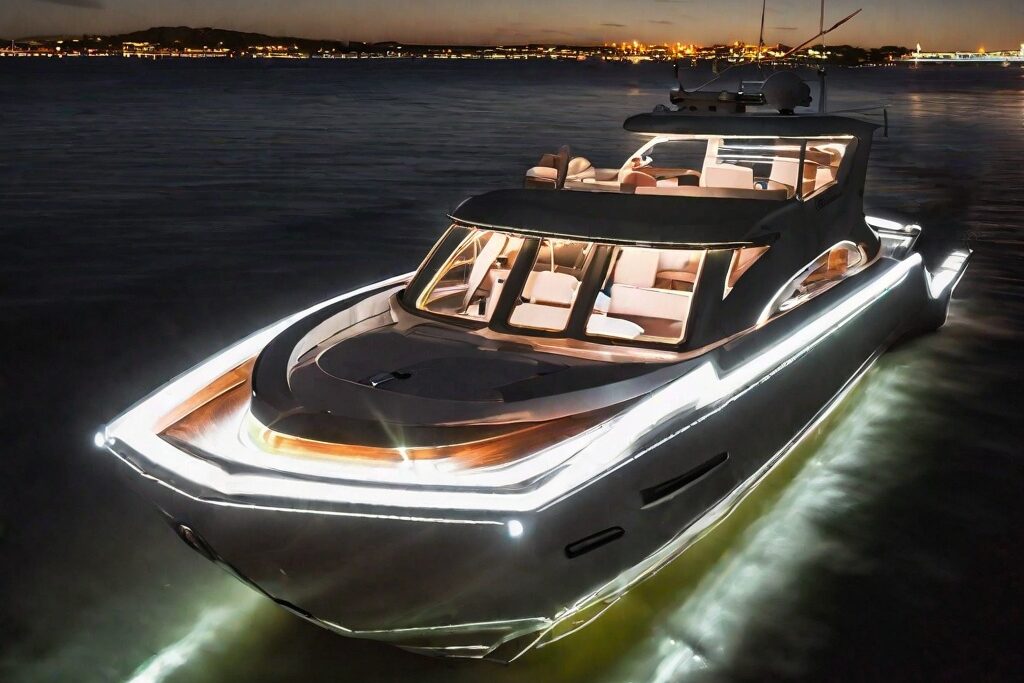
Installing LED Lights on a Pontoon Boat
When it comes to installing LED lights on a pontoon boat, there are several essential steps you’ll need to take.
Step-1: Choosing an LED light
If you plan to install LED lights on your pontoon boat, it’s important to know what LED lights you want to use. With so many different types and styles available on the market today, taking the time to research your options can help you choose the best LEDs for your needs. Once you’ve decided on the type of LEDs, you should determine your desired light output and find a fixture that matches those specifications. One key consideration is ensuring that the LED lights you select are RGB, meaning they can change colors. This feature will allow you to create stunning lighting effects on your boat and avoid being stuck with a single color.
Another critical factor to remember is to check whether the LED lights are waterproof before purchasing. Installing non-waterproof LED lights can lead to malfunctions and potentially dangerous situations, so be sure to choose lights designed for use on boats. By following these steps and doing your research, you can ensure that you choose the right LED lights for your pontoon boat and avoid any unwanted surprises later on.

No products found.
Step 2: Plan the Layout
Before starting the installation, you must plan where you want to install the LED lights on your pontoon boat. Consider the areas that need more lighting and determine how many lights you will need, where they will be placed, and how they will be powered. A well-thought-out plan will save you time and money in the long run, as it ensures you have all the necessary supplies and helps you avoid making mistakes during the installation process.
Step 3: Gather the Supplies
Once you’ve planned the layout, gather all the necessary supplies, including the LED lights, wiring, connectors, switches, and waterproof housing (if required). Choose high-quality, marine-grade supplies designed to withstand the harsh marine environment. This will ensure that your LED lights last longer and operate safely, even in wet conditions.
Step 4: Prepare the Boat
Before installing the LED lights, you need to prepare the boat’s surface by cleaning the areas where the lights will be installed. Ensure the surface is dry and free of debris to allow for proper adhesion. If drilling is required, mark the locations and use a drill to make holes, being careful not to damage the boat’s structure or wiring.
Step 5: Install the Lights
Attach the LED lights to their designated locations, following the manufacturer’s instructions. Ensure the lights are mounted securely and the wiring is properly connected. Use waterproof connectors to protect the wiring from moisture and avoid short circuits. If the LED lights are not waterproof, use a waterproof housing or silicone sealant to protect them from water damage.
Step 6: Connect to the Power Source
Wire the LED lights to the power source using connectors, switches, and fuses as needed. Test the lights to ensure they’re functioning correctly and the wiring is not overloaded or overheated. It’s important to ensure that the wiring is securely attached to the lights and the power source and that it’s not loose or exposed.
Step 7: Secure the Wiring
Secure the wiring along the boat’s surface using wire ties, clips, or clamps. This will prevent the wiring from dangling and getting caught in objects, which can damage the wiring or the lights. Ensure that the wiring is properly insulated and protected from moisture and that it’s not obstructing any moving parts or blocking access to essential components.
Step 8: Seal and Waterproof
If necessary, seal the LED lights with a waterproof housing or silicone sealant to protect them from water damage. This step is critical for ensuring the longevity of the LED lights, especially if they’re regularly exposed to water or moisture. Additionally, ensure that the sealant or housing is secure and not blocking the light output or obstructing the view.
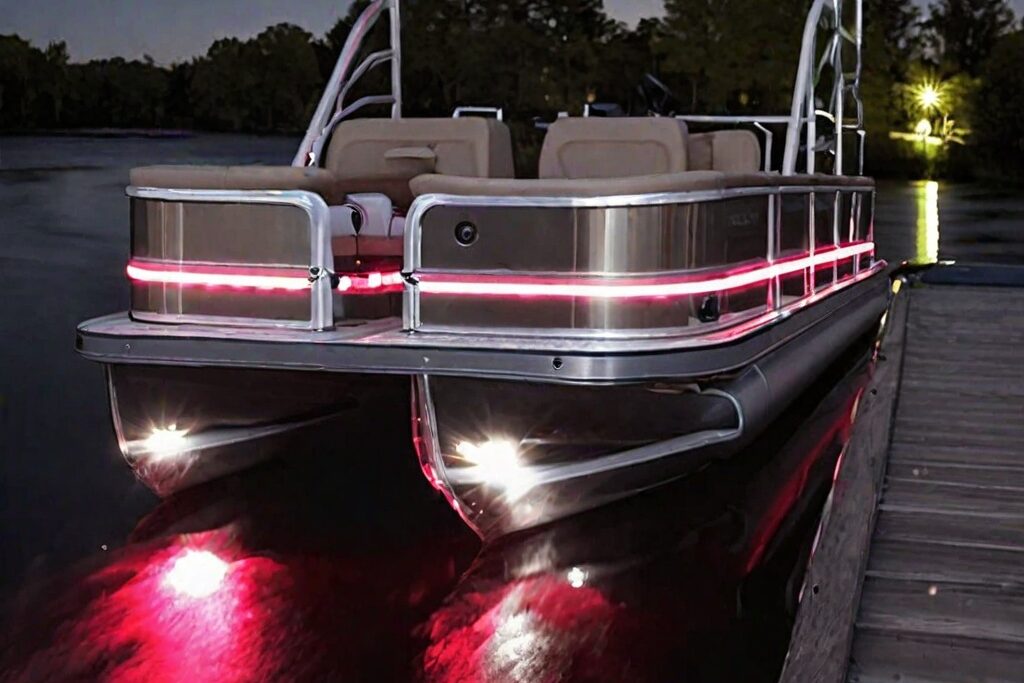
Do I need LED lights on my pontoon boat?
LED Lights on boats are essential for a variety of reasons. They help boaters see other boats in low visibility conditions and prevent collisions. In addition, lights are required while operating under reduced visibility conditions. International maritime regulations require you to have certain lights on your boat. The masthead light must be white, and the all-around light must be white or red/green.
Adding additional lights to your boat is a good idea. Additional lights can make it easier to dock at night and light up your deck. Lights also provide safety for you and your passengers when boating in the dark. Ensure all your lights are working correctly before hitting the water and always obey maritime regulations.
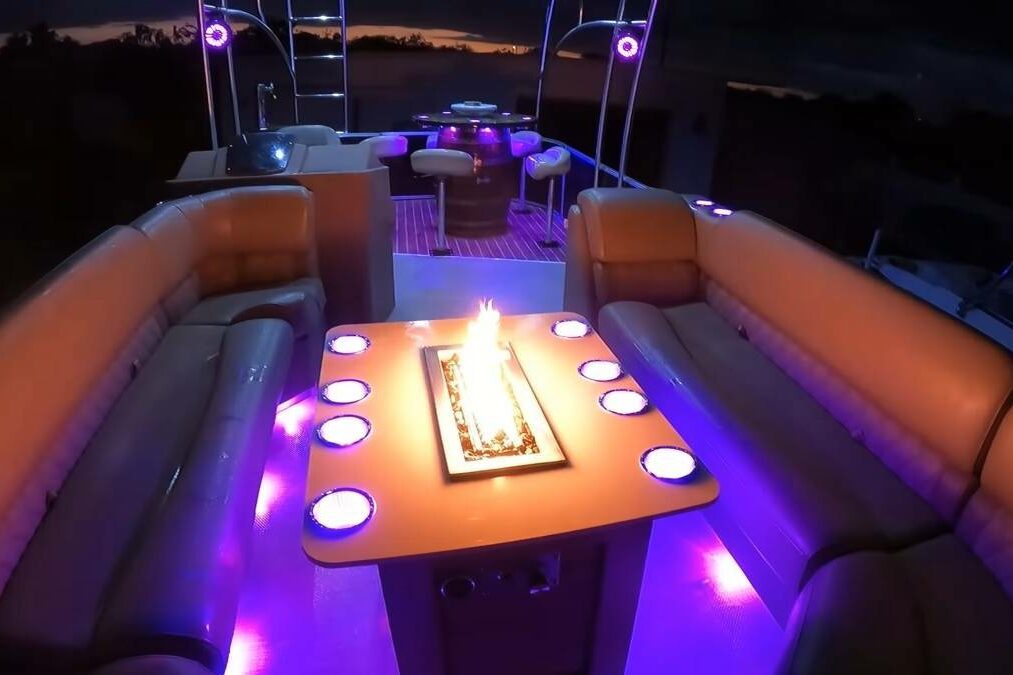
What are the benefits of installing LED lights on my pontoon boat?
Installing LED lights on your pontoon boat can provide a range of practical and aesthetic benefits. One of the most significant benefits of LED lights is improved visibility. LED lights can illuminate the water and surrounding areas, making navigating and spotting obstacles or other boats easier, especially during nighttime boating or fishing activities. Additionally, LED lights are highly energy-efficient, consuming up to 90% less power than traditional incandescent bulbs.
This can help reduce your overall energy consumption and save you money on fuel costs. LED lights also have a longer lifespan than traditional bulbs, lasting up to 50,000 hours or more, which means less frequent replacements and maintenance over time. LED lights come in a variety of colors.
They can be customized to fit your desired lighting needs, allowing you to create a unique and personalized lighting effect that enhances the overall ambiance of your boat. LED lights emit very little heat, making them safe to use in enclosed spaces or around flammable materials and reducing the fire risk. Lastly, LED lights are built to withstand harsh marine conditions, including exposure to saltwater, wind, and UV rays, making them a reliable choice for marine lighting.
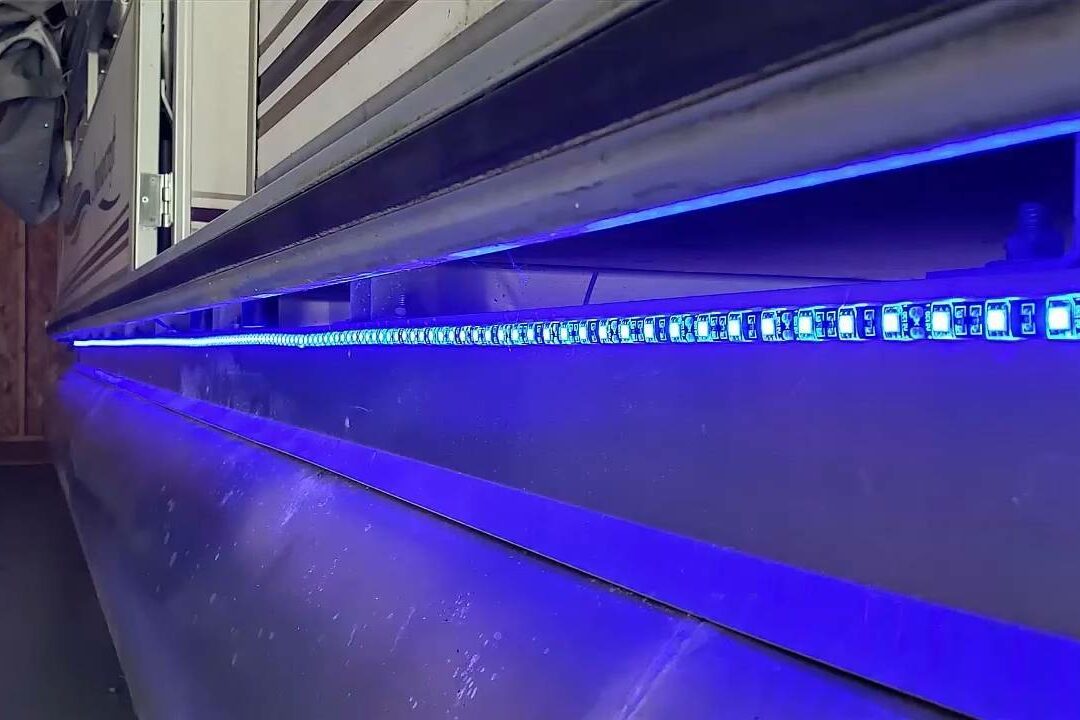
What are some tips for installing LED lights on my pontoon boat?
• Choose High-Quality LED Lights: Invest in high-quality LED lights designed for marine use. Choose lights with waterproof housing, a long lifespan, and the ability to withstand harsh marine conditions.
• Plan the Layout: Plan the location and layout of the LED lights before installation. This will ensure you have all the necessary supplies and that the installation goes smoothly.
• Use Marine-Grade Wiring and Connectors: Choose marine-grade wiring and connectors that can withstand the marine environment. Ensure that the wiring is rated for outdoor use, adequately insulated, and protected from moisture.
• Ensure Proper Wiring: Ensure that the wiring is securely attached to the lights and the power source and that there is no exposed wiring that can be damaged by water or other elements.
• Use Waterproof Sealing: If necessary, use waterproof sealing to protect the LED lights from water damage. Apply a silicone sealant or waterproof housing to protect the lights from moisture and water splashes.
• Test the Lights: Before launching the boat, test the LED lights to ensure they function correctly. Check for loose connections, flickering, or dimming lights, and make necessary adjustments.
• Take Safety Precautions: Always take safety precautions when working with electrical wiring. Turn off the power source before installation and avoid touching the wiring with wet hands. Also, use the proper tools and equipment to prevent accidents or damage to the boat.
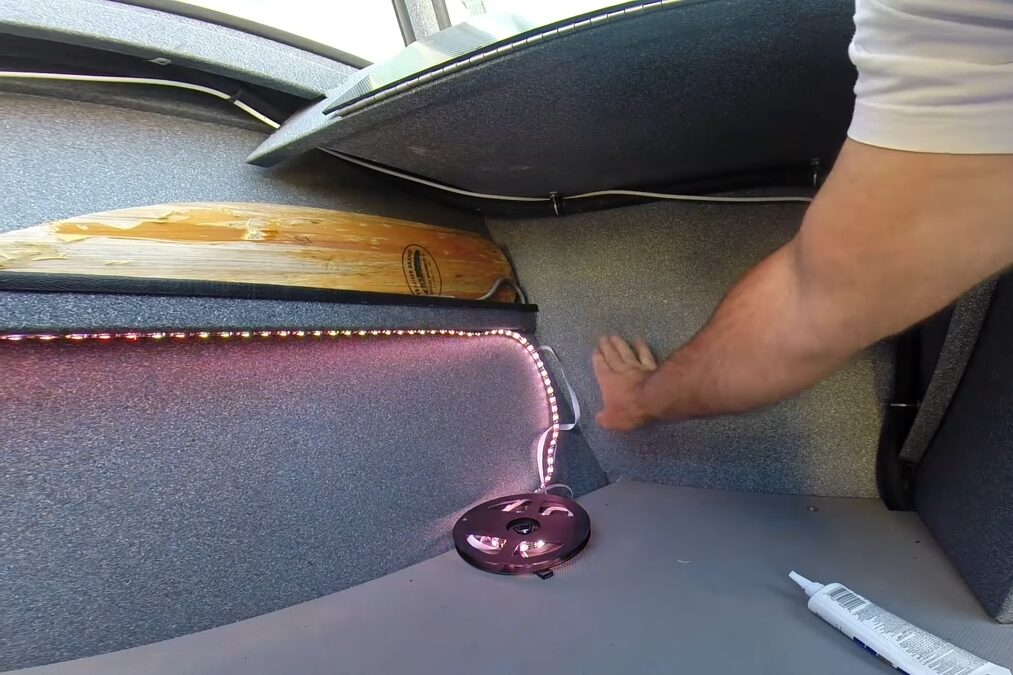
FAQs
What are some common LED light installation mistakes on pontoon boats?
When installing LED lights on a pontoon boat, it’s essential to be aware of some common mistakes people make. For example, many people don’t realize that each set of LEDs needs to be connected to a controller with 12-volt power in order for the lights to work correctly.
Additionally, it’s essential not to exceed the recommended mounting height when installing underwater LEDs. If you go over the height limit, you risk damaging the light or, even worse, causing an electrical fire on your boat.
It’s also a good idea to install lights above the waterline if possible, as they will shine brighter underwater due to light attenuation in the water column (approx 4 meters). And finally, remember to angle the LED light downwards at 10 degrees in order for it to shine down into the water.
What are the best LED lights for pontoon boats?
If you’re looking for the best LED lights for your pontoon boat, you’ve come to the right place. These lights are easy to install, waterproof, and have a sleek design that will make your boat look great. Plus, they’re perfect for underwater applications!
Installation is straightforward. All you need is 12V power, and these LED lights will do the rest. You might also want to buy 5/8 inch clear tubing if you plan on using these LED lights underwater. This tubing will help protect them from damage and keep them functioning properly for years to come.
So what are you waiting for? Get yourself some of the best LED lights on the market today and enjoy all the benefits they have to offer!
How much do LED lights cost for a pontoon boat?
The cost of installing LED lights on your Pontoon Boat depends on how many LED lights you need. And if you’re doing it yourself or want a professional to do the job. The average cost of installing an LED light kit on a pontoon is about $100-$300. The price can vary depending on what type of LED light you use and where you buy it from.

